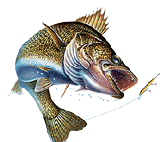|
Swimming with Early Ice
Walleyes
by Ron Anlauf
Swimming baits can be the
big ticket to solid early
 season
catches and are always a good option for icing heavy duty walleyes. Some may
argue “the always” point but when given a fair chance I’ve yet to find water
where they don’t produce. season
catches and are always a good option for icing heavy duty walleyes. Some may
argue “the always” point but when given a fair chance I’ve yet to find water
where they don’t produce.
An accepted rule of thumb
has been “clear water only” and that they really don’t work on darker bodies of
water. The fact is that particular rule of thumb is simply wrong. It takes
some initiative and an inquisitive nature to go where none have gone before but
that’s where it’s at when it comes to uncovering the next big thing. Anglers
that have been willing to experiment and use baits where they’re not supposed to
have found that they can sometimes more catch fish (and maybe even bigger), than
what conventional techniques can deliver.
Tom Ahlman of Isanti,
Minnesota is one of those experimental types and has found that a minnow style
bait can be the perfect companion to a jigging spoon. He uses the spoon to get
the attention of hungry eyes and the minnow bait to close the deal. His
technique consists of setting a trap by lifting the minnow bait off of the
bottom five or six feet or so and letting it set perfectly still while working
close to the bottom with a spoon. When walleyes come in and won’t hit the spoon
he’ll try and work them up until they’re just under the minnow and then give it
a twitch. More often than not walleyes will give up on the spoon and gobble up
the minnow lure. Better yet he does a lot of “trapping” on Lake of Woods in
northern Minnesota where swim baits aren’t supposed to work because the water is
too darn dark.
Typical ice fishing
presentations include dropping a swimming bait like Northland Tackles 3/8oz Mini
Airplane Jig to the bottom and lifting it up just off the bottom and allowing it
to rest a moment before starting with an upward sweep or pull of the rod,
followed by letting the bait freefall back to the beginning position. As the
bait is pulled upward it kicks out a foot or more, and then turns back and
glides into the stationary position. This is accomplished by a set of swimming
fins attached to the rear portion of the bait, and sets it apart form any other
so called jigging bait. The kick out is an attention getter while the glide
back in can trigger a positive response. Because the bait covers a wider range
than directly below the hole and that it creates an aggressive action the bait
can draw fish in from greater distances than other lures. As the bait glides
back to it’s starting position watch the line as it get’s pulled off the surface
of the water to be sure that the slack is pulled out and it hasn’t stopped
short. If it stops before it gets all the way down it’s been picked up and is
time to set the hook. With all those hooks there’s no better time to rip some
lips than right than right now.
The sweep and kick out is
the aggressive part of the presentation, while the glide and settle is much more
subtle. Even when fish are in a positive feeding mood; subtle may be the key to
tripping their triggers.
Walleyes for example will
often come in and eyeball a bait for quite awhile before deciding either to
accept or reject the offering. If it doesn’t get hit and you’ve got a fish
following on the flasher let it set for a couple of seconds and then give it a
very slight twitch. That little twitch accounts for the lion’s share of my on
ice ‘eyes and is a real closer.
Although the lure can be
extremely effective on it=s
own the Mini Airplane Jig is most often tipped with some form of live bait and
usually includes a minnow or piece of minnow, or even a wax worm, depending on
the size and species of fish you=re
after. Tipping the bait is accomplished by attaching the live bait to one or
all of the hooks. Typically the bottom treble hook is used and has little
effect on the action of the bait as long as you don’t overdue it. That means
using a whole minnow only if it’s small enough not to restrict the action of the
lure. Minnows that are too large can keep the bait from doing what it=s
supposed to do which is swing out and settle back in. A better option may be
simple using the head of a larger minnow which gives the lure added scent and
flavor and can make a real difference when the going gets a little tough. When
it’s good; the lure itself is all you’ll need and it can pay to experiment.
If you decide to give swim
baits a go be sure to tie in a small swivel a couple of feet or so above the
lure. All that swimming and turning creates a ton of line twist and you’ll end
up with a real mess if you don’t heed this seemingly minor piece of advice. See
you on the ice. |


 season
catches and are always a good option for icing heavy duty walleyes. Some may
argue “the always” point but when given a fair chance I’ve yet to find water
where they don’t produce.
season
catches and are always a good option for icing heavy duty walleyes. Some may
argue “the always” point but when given a fair chance I’ve yet to find water
where they don’t produce.